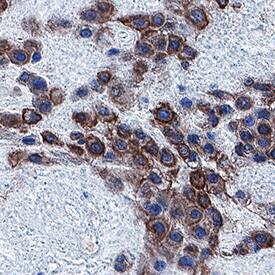Human PlGF-3 Antibody
R&D Systems, part of Bio-Techne | Catalog # MAB7758

Key Product Details
Species Reactivity
Human
Applications
Immunohistochemistry
Label
Unconjugated
Antibody Source
Monoclonal Mouse IgG2B Clone # 1039018
Product Specifications
Immunogen
Spodoptera frugiperda Sf21 (baculovirus)-derived human PlGF-3
Leu19-Arg221
Accession # P49763
Leu19-Arg221
Accession # P49763
Specificity
Detects human PIGF-3 in direct ELISAs.
Clonality
Monoclonal
Host
Mouse
Isotype
IgG2B
Scientific Data Images for Human PlGF-3 Antibody
PlGF-3 in Human Placenta.
PlGF-3 was detected in immersion fixed paraffin-embedded sections of human placenta using Mouse Anti-Human PlGF-3 Monoclonal Antibody (Catalog # MAB7758) at 5 µg/mL for 1 hour at room temperature followed by incubation with the Anti-Mouse IgG VisUCyte™ HRP Polymer Antibody (VC001). Before incubation with the primary antibody, tissue was subjected to heat-induced epitope retrieval using Antigen Retrieval Reagent-Basic (CTS013). Tissue was stained using DAB (brown) and counterstained with hematoxylin (blue). Specific staining was localized to decidual cells. Staining was performed using our protocol for IHC Staining with VisUCyte HRP Polymer Detection Reagents.Applications for Human PlGF-3 Antibody
Application
Recommended Usage
Immunohistochemistry
5-25 µg/mL
Sample: Immersion fixed paraffin-embedded sections of human placenta
Sample: Immersion fixed paraffin-embedded sections of human placenta
Reviewed Applications
Read 1 review rated 5 using MAB7758 in the following applications:
Formulation, Preparation, and Storage
Purification
Protein A or G purified from hybridoma culture supernatant
Reconstitution
Reconstitute at 0.5 mg/mL in sterile PBS. For liquid material, refer to CoA for concentration.
Formulation
Lyophilized from a 0.2 μm filtered solution in PBS with Trehalose. *Small pack size (SP) is supplied either lyophilized or as a 0.2 µm filtered solution in PBS.
Shipping
Lyophilized product is shipped at ambient temperature. Liquid small pack size (-SP) is shipped with polar packs. Upon receipt, store immediately at the temperature recommended below.
Stability & Storage
Use a manual defrost freezer and avoid repeated freeze-thaw cycles.
- 12 months from date of receipt, -20 to -70 °C as supplied.
- 1 month, 2 to 8 °C under sterile conditions after reconstitution.
- 6 months, -20 to -70 °C under sterile conditions after reconstitution.
Background: PlGF-3
References
- Cao, Y. et al. (1997) Biochem. Biophys. Res. Commun. 235:493.
- Yang, W. et al. (2003) J. Reprod. Immunol. 60:53.
- Ribatti, D. (2008) Angiogenesis 11:215.
- Eriksson, A. et al. (2002) Cancer Cell 1:99.
- Oura, H. et al. (2003) Blood 101:560.
- Roncal, C. et al. (2010) Cardiovasc. Res. 86:29.
- Levine, R.J. et al. (2004) N. Engl. J. Med. 350:672.
- Carmeliet, P. et al. (2001) Nat. Med. 7:575.
- Autiero, M. et al. (2003) Nat. Med. 9:936.
- Migdal, M. et al. (1998) J. Biol. Chem. 273:22272.
- Perelman, N. et al. (2003) Blood 102:1506.
- Cianfarani, F. et al. (2006) Am. J. Pathol. 169:1167.
- Maes, C. et al. (2006) J. Clin. Invest. 116:1230.
- Fischer, C. et al. (2008) Nat. Rev. Cancer 8:942.
- Schultze, A. et al. (2012) Clin. Exp. Metastasis Apr 8 [Epub ahead of print].
Long Name
Placenta Growth Factor 3
Alternate Names
PlGF3
Entrez Gene IDs
5228 (Human)
Gene Symbol
PGF
UniProt
Additional PlGF-3 Products
Product Documents for Human PlGF-3 Antibody
Product Specific Notices for Human PlGF-3 Antibody
For research use only
